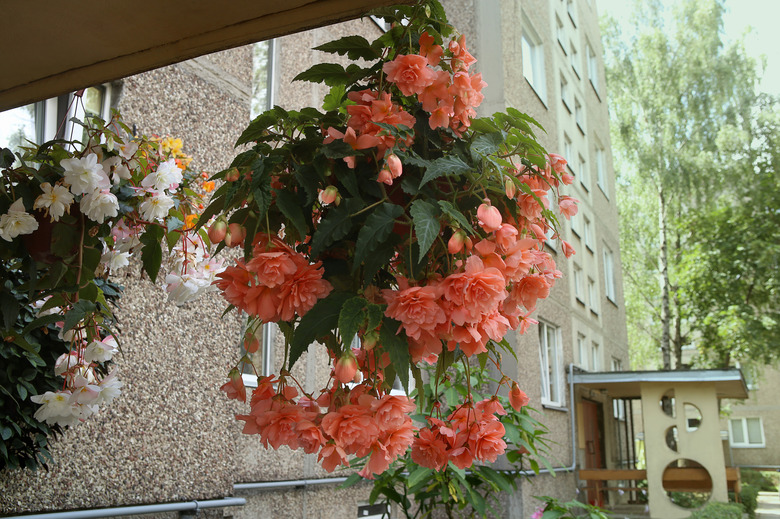How To Care For Hanging Basket Begonias
We may receive a commission on purchases made from links.
Few plants are more versatile than the begonia (Begonia spp.), which comes in many different types, and begonia care is specific to the type. One group is especially well-adapted to growing in a hanging planter or basket, either outdoors or in the house. This type of begonia is called trailing or scadent —scadent means "climbing" — because its branches can become quite long, in some varieties up to 8 feet, making them ideal for hanging baskets. For example, some hybrid tuberous begonias (Begonia [Tuberosa Group]) have this type of growth habit and do especially well as hanging plants. They grow in U.S. Department of Agriculture plant hardiness zones 9 through 11 but can also grow as annuals or houseplants, needing only basic care and occasional trimming to thrive.
Light Requirements of Hanging Basket Begonias
Light Requirements of Hanging Basket Begonias
Provide trailing begonias with strong light to produce a full, multistemmed plant with lots of flowers. If you grow the plant outdoors, keep it in a spot that gets some filtered sun in the morning, but avoid hot sun at midday or during the afternoon hours because this could burn the plant. A spot under a widely branched tree that provides shifting sun and partial shade is ideal. Indoors, keep a houseplant in a bright spot, such as in an east window where it gets some morning sun.
If the leaves start to fade and become light green, this indicates that the begonia is getting too much light, so move the plant to a shadier spot. If the stems get extra-long, with long spans between leaf origins, this signals that the plant needs more light; in this case, move it to a brighter spot.
Water Needs of Hanging Basket Begonias
Water Needs of Hanging Basket Begonias
Hanging begonia plants do best when their soil is evenly moist, but it's important not to overwater because this can cause constantly soggy soil which can damage the plant and, if not corrected, might kill it. For an indoor-grown plant, water whenever the top inch or two feels dry to the touch, allowing the pot to drain fully. Never keep the pot in a water-filled saucer because this can cause root rot.
A hanging begonia grown outdoors needs watering whenever its soil surface feels dry. It's a good idea to check this every few days during the summer because hot weather can cause the soil to dry quickly.
Whether grown indoors or in the garden, a begonia slows its growth during winter when it rests, so cut back on watering during the winter months.
Fertilizing Guidelines for Hanging Basket Begonias
Fertilizing Guidelines for Hanging Basket Begonias
Fertilizing a hanging begonia every other time you give it water helps keep the plant growing and flowering during it active season, usually from spring until early fall. Use a balanced formula, such as 20-20-20, diluting it to half-strength or about 1/4 teaspoon per gallon of water, but check your product label for specific directions.
To boost flowering, you can switch to a high-phosphorus formula just before flowering starts, usually in early summer, to help set more flower buds. For example, use a 15-30-15 formula, diluting 1 tablespoon in 1 gallon of water for garden plants and 1/2 teaspoon per gallon for houseplants, but check the product label for additional information. Feed the plant every one or two weeks until the blooming season ends, usually in fall. Withhold fertilizer during winter to give the plant a rest.
Trimming and Other Care for Hanging Basket Begonias
Trimming and Other Care for Hanging Basket Begonias
Trailing begonias in hanging planters can start appearing leggy as the season progresses and the stems get longer. Encourage bushier growth and lateral branching by pinching back the growing tips frequently, using your fingertips or pruning shears whose blades you wipe with rubbing alcohol between cuts to avoid spreading plant diseases. By varying the length of stems through trimming, you can also produce a more shapely plant. For an older plant, remove some old stems now and then to encourage new growth from the plant's base.
Begonias are usually free of significant disease problems, but they can attract several pests, including fluffy white mealybugs. Control these by touching each pest with a cotton swab dipped in rubbing alcohol to destroy it. The plant might also attract spider mites, which form visible, weblike coverings on leaves and flowers. Destroy these pests by spraying the plant thoroughly with insecticidal soap, diluted at a rate of 5 tablespoons per gallon of water; repeat this every two weeks as needed.
Protecting Hanging Basket Begonias From Frost
Protecting Hanging Basket Begonias From Frost
If you grow a hanging begonia outdoors year-round and expect unusual cold or even a bit of frost, bring the plant inside until the weather warms as a freeze may kill it. You can also leave it outdoors, but protect it by hanging a light cloth from the planter's hook so it covers the entire plant, or by placing the planter in a plastic bag that's large enough to enclose the entire plant, tying the bag's open ends to the planter's hook. Be careful when removing any covering so that you don't injure stems or flower buds.
